2004 PONTIAC BONNEVILLE air condition
[x] Cancel search: air conditionPage 142 of 446
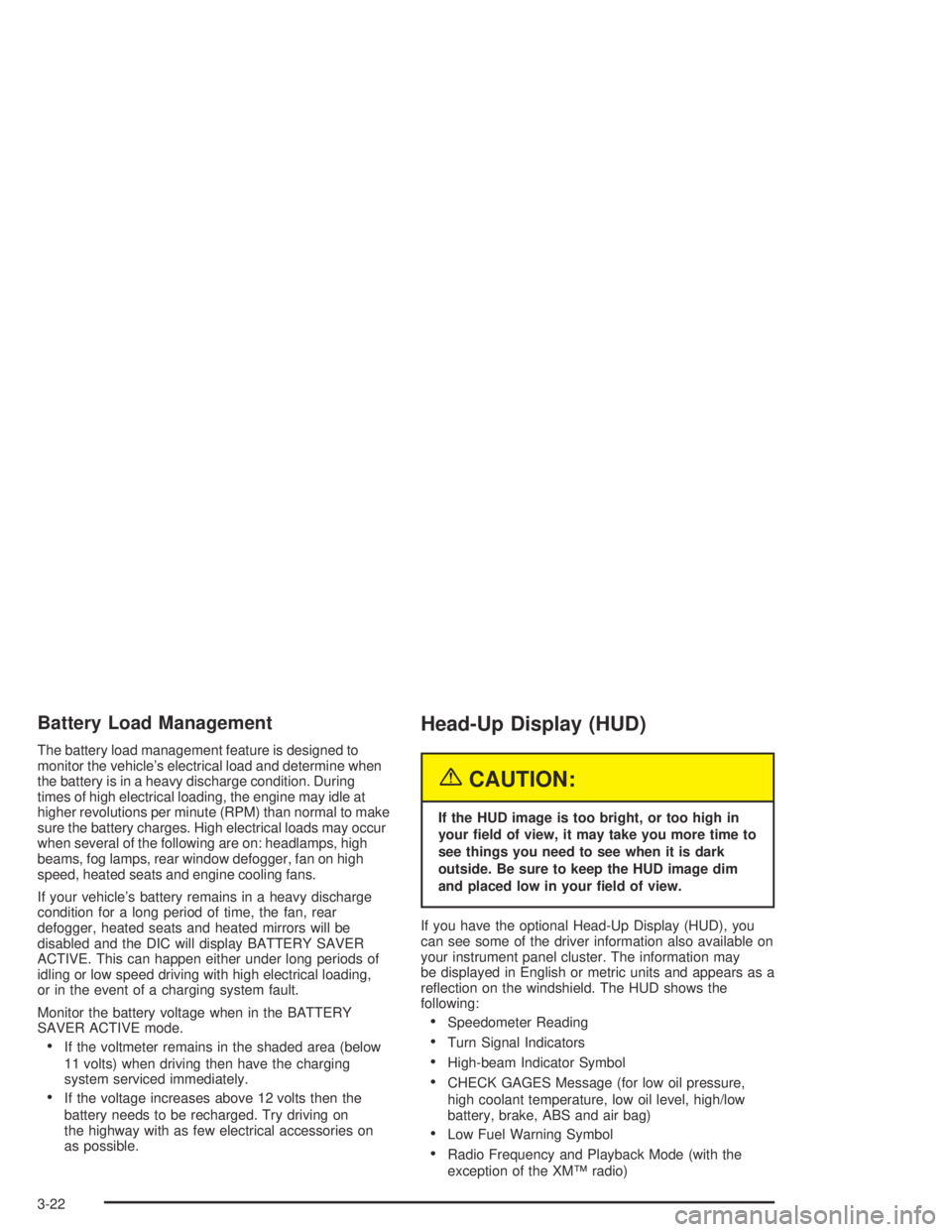
Battery Load Management
The battery load management feature is designed to
monitor the vehicle’s electrical load and determine when
the battery is in a heavy discharge condition. During
times of high electrical loading, the engine may idle at
higher revolutions per minute (RPM) than normal to make
sure the battery charges. High electrical loads may occur
when several of the following are on: headlamps, high
beams, fog lamps, rear window defogger, fan on high
speed, heated seats and engine cooling fans.
If your vehicle’s battery remains in a heavy discharge
condition for a long period of time, the fan, rear
defogger, heated seats and heated mirrors will be
disabled and the DIC will display BATTERY SAVER
ACTIVE. This can happen either under long periods of
idling or low speed driving with high electrical loading,
or in the event of a charging system fault.
Monitor the battery voltage when in the BATTERY
SAVER ACTIVE mode.
If the voltmeter remains in the shaded area (below
11 volts) when driving then have the charging
system serviced immediately.
If the voltage increases above 12 volts then the
battery needs to be recharged. Try driving on
the highway with as few electrical accessories on
as possible.
Head-Up Display (HUD)
{CAUTION:
If the HUD image is too bright, or too high in
your �eld of view, it may take you more time to
see things you need to see when it is dark
outside. Be sure to keep the HUD image dim
and placed low in your �eld of view.
If you have the optional Head-Up Display (HUD), you
can see some of the driver information also available on
your instrument panel cluster. The information may
be displayed in English or metric units and appears as a
re�ection on the windshield. The HUD shows the
following:
Speedometer Reading
Turn Signal Indicators
High-beam Indicator Symbol
CHECK GAGES Message (for low oil pressure,
high coolant temperature, low oil level, high/low
battery, brake, ABS and air bag)
Low Fuel Warning Symbol
Radio Frequency and Playback Mode (with the
exception of the XM™ radio)
3-22
Page 147 of 446
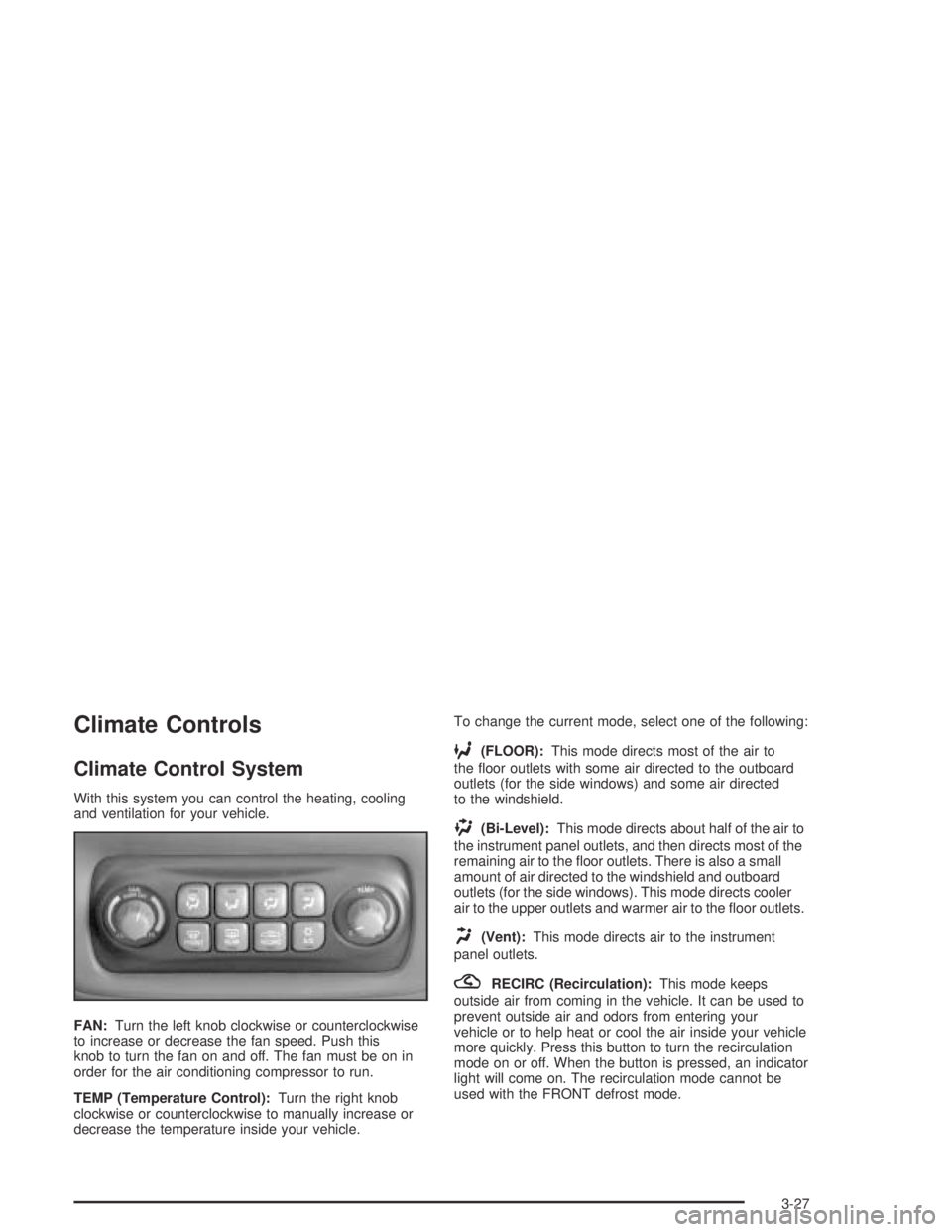
Climate Controls
Climate Control System
With this system you can control the heating, cooling
and ventilation for your vehicle.
FAN:Turn the left knob clockwise or counterclockwise
to increase or decrease the fan speed. Push this
knob to turn the fan on and off. The fan must be on in
order for the air conditioning compressor to run.
TEMP (Temperature Control):Turn the right knob
clockwise or counterclockwise to manually increase or
decrease the temperature inside your vehicle.To change the current mode, select one of the following:
6(FLOOR):This mode directs most of the air to
the �oor outlets with some air directed to the outboard
outlets (for the side windows) and some air directed
to the windshield.
)(Bi-Level):This mode directs about half of the air to
the instrument panel outlets, and then directs most of the
remaining air to the �oor outlets. There is also a small
amount of air directed to the windshield and outboard
outlets (for the side windows). This mode directs cooler
air to the upper outlets and warmer air to the �oor outlets.
H(Vent):This mode directs air to the instrument
panel outlets.
?RECIRC (Recirculation):This mode keeps
outside air from coming in the vehicle. It can be used to
prevent outside air and odors from entering your
vehicle or to help heat or cool the air inside your vehicle
more quickly. Press this button to turn the recirculation
mode on or off. When the button is pressed, an indicator
light will come on. The recirculation mode cannot be
used with the FRONT defrost mode.
3-27
Page 148 of 446
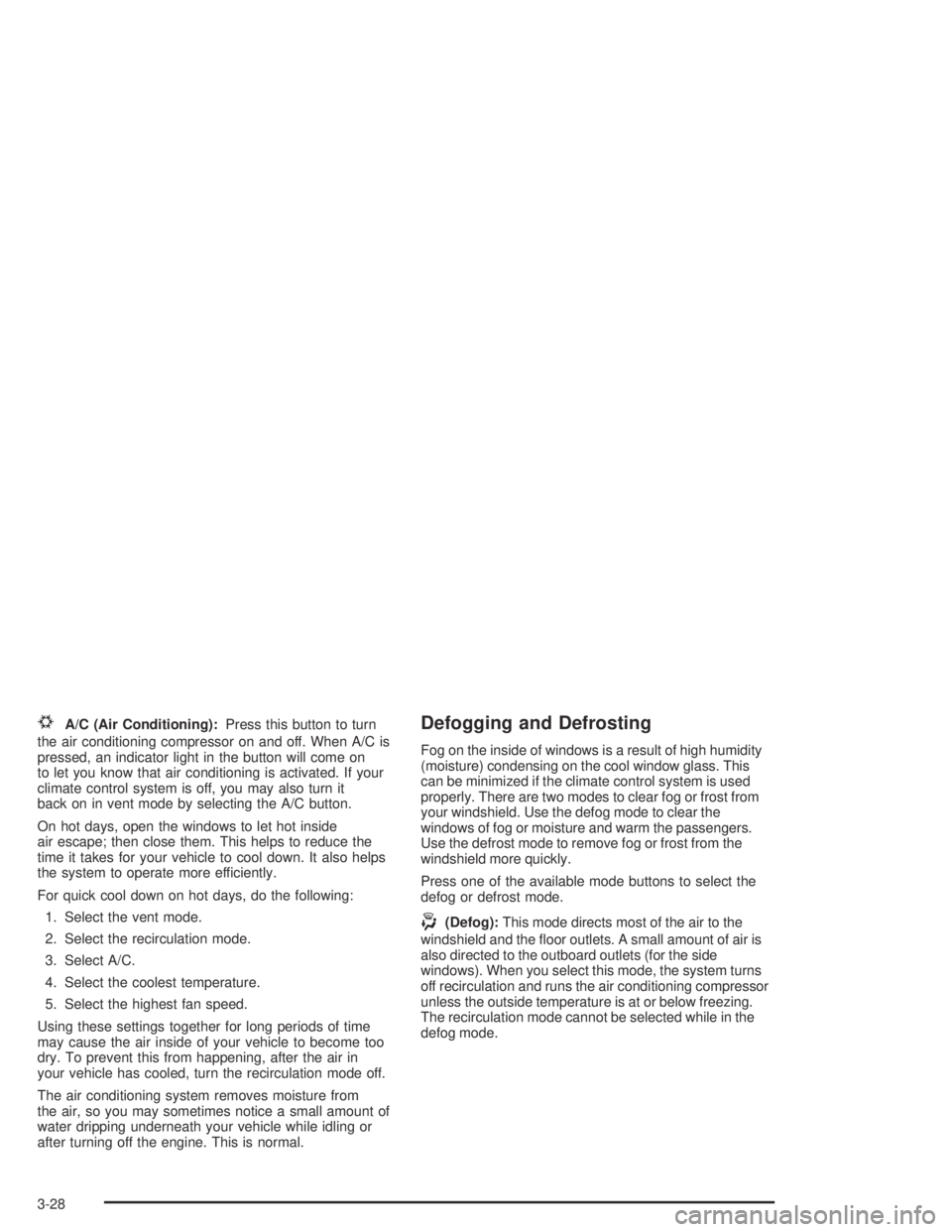
#A/C (Air Conditioning):Press this button to turn
the air conditioning compressor on and off. When A/C is
pressed, an indicator light in the button will come on
to let you know that air conditioning is activated. If your
climate control system is off, you may also turn it
back on in vent mode by selecting the A/C button.
On hot days, open the windows to let hot inside
air escape; then close them. This helps to reduce the
time it takes for your vehicle to cool down. It also helps
the system to operate more efficiently.
For quick cool down on hot days, do the following:
1. Select the vent mode.
2. Select the recirculation mode.
3. Select A/C.
4. Select the coolest temperature.
5. Select the highest fan speed.
Using these settings together for long periods of time
may cause the air inside of your vehicle to become too
dry. To prevent this from happening, after the air in
your vehicle has cooled, turn the recirculation mode off.
The air conditioning system removes moisture from
the air, so you may sometimes notice a small amount of
water dripping underneath your vehicle while idling or
after turning off the engine. This is normal.Defogging and Defrosting
Fog on the inside of windows is a result of high humidity
(moisture) condensing on the cool window glass. This
can be minimized if the climate control system is used
properly. There are two modes to clear fog or frost from
your windshield. Use the defog mode to clear the
windows of fog or moisture and warm the passengers.
Use the defrost mode to remove fog or frost from the
windshield more quickly.
Press one of the available mode buttons to select the
defog or defrost mode.
-(Defog):This mode directs most of the air to the
windshield and the �oor outlets. A small amount of air is
also directed to the outboard outlets (for the side
windows). When you select this mode, the system turns
off recirculation and runs the air conditioning compressor
unless the outside temperature is at or below freezing.
The recirculation mode cannot be selected while in the
defog mode.
3-28
Page 149 of 446
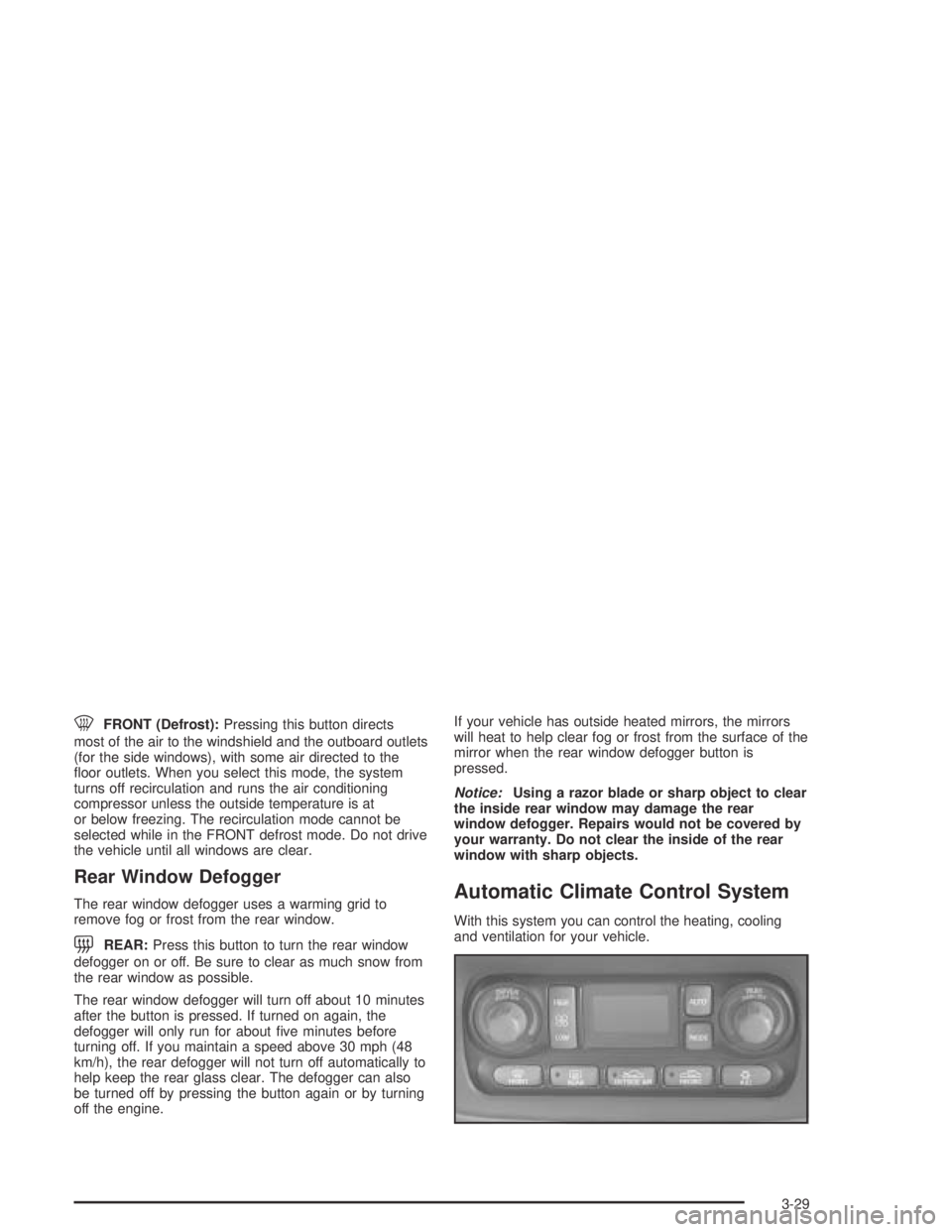
0FRONT (Defrost):Pressing this button directs
most of the air to the windshield and the outboard outlets
(for the side windows), with some air directed to the
�oor outlets. When you select this mode, the system
turns off recirculation and runs the air conditioning
compressor unless the outside temperature is at
or below freezing. The recirculation mode cannot be
selected while in the FRONT defrost mode. Do not drive
the vehicle until all windows are clear.
Rear Window Defogger
The rear window defogger uses a warming grid to
remove fog or frost from the rear window.
=REAR:Press this button to turn the rear window
defogger on or off. Be sure to clear as much snow from
the rear window as possible.
The rear window defogger will turn off about 10 minutes
after the button is pressed. If turned on again, the
defogger will only run for about �ve minutes before
turning off. If you maintain a speed above 30 mph (48
km/h), the rear defogger will not turn off automatically to
help keep the rear glass clear. The defogger can also
be turned off by pressing the button again or by turning
off the engine.If your vehicle has outside heated mirrors, the mirrors
will heat to help clear fog or frost from the surface of the
mirror when the rear window defogger button is
pressed.
Notice:Using a razor blade or sharp object to clear
the inside rear window may damage the rear
window defogger. Repairs would not be covered by
your warranty. Do not clear the inside of the rear
window with sharp objects.
Automatic Climate Control System
With this system you can control the heating, cooling
and ventilation for your vehicle.
3-29
Page 152 of 446

?RECIRC (Recirculation):Press this button to
limit the amount of outside air coming into the vehicle. It
can be used to prevent outside air and odors from
entering your vehicle or to help heat or cool the
air inside your vehicle more quickly. Press this button to
turn the recirculation mode on or off. When the button
is pressed, an indicator light will come on. The
recirculation mode cannot be used with the FRONT
defrost mode.
#A/C (Air Conditioning):Press this button to
override the automatic system and turn the air
conditioning system on or off. When A/C is pressed, an
indicator light in the button will come on to let you
know that it is activated. When in AUTO, the air
conditioning compressor will come on automatically, as
necessary. The air conditioning compressor will also
run when you select the FRONT defrost mode and
outside temperatures are above freezing.
On hot days, open the windows to let hot inside air
escape; then close them. This helps to reduce the time
it takes for your vehicle to cool down. It also helps
the system to operate more efficiently.
For quick cool down on hot days, press the AUTO
button and the system will automatically enter
recirculation mode and the temperature will be at the full
cold position for maximum cooling.Using these settings together for long periods of time
may cause the air inside of your vehicle to become too
dry. To prevent this from happening, after the air in
your vehicle has cooled, turn the recirculation mode off.
The air conditioning system removes moisture from
the air, so you may sometimes notice a small amount of
water dripping underneath your vehicle while idling or
after turning off the engine. This is normal.Sensors
The solar sensor on your vehicle monitors the solar
radiation and the air inside of your vehicle, then uses the
information to maintain the selected temperature by
initiating needed adjustments to the temperature, the fan
speed and the air delivery system. The system may
also supply cooler air to the side of the vehicle facing the
sun. The recirculation mode will also be activated, as
necessary. Do not cover the solar sensor located in the
center of the instrument panel, near the windshield,
or the system will not work properly.
There is also an EXT (exterior) temperature sensor
located behind the front grill. This sensor reads
the outside air temperature and helps to maintain the
temperature inside the vehicle. Any cover on the front of
the vehicle could cause a false reading in the
temperature.
3-32
Page 153 of 446
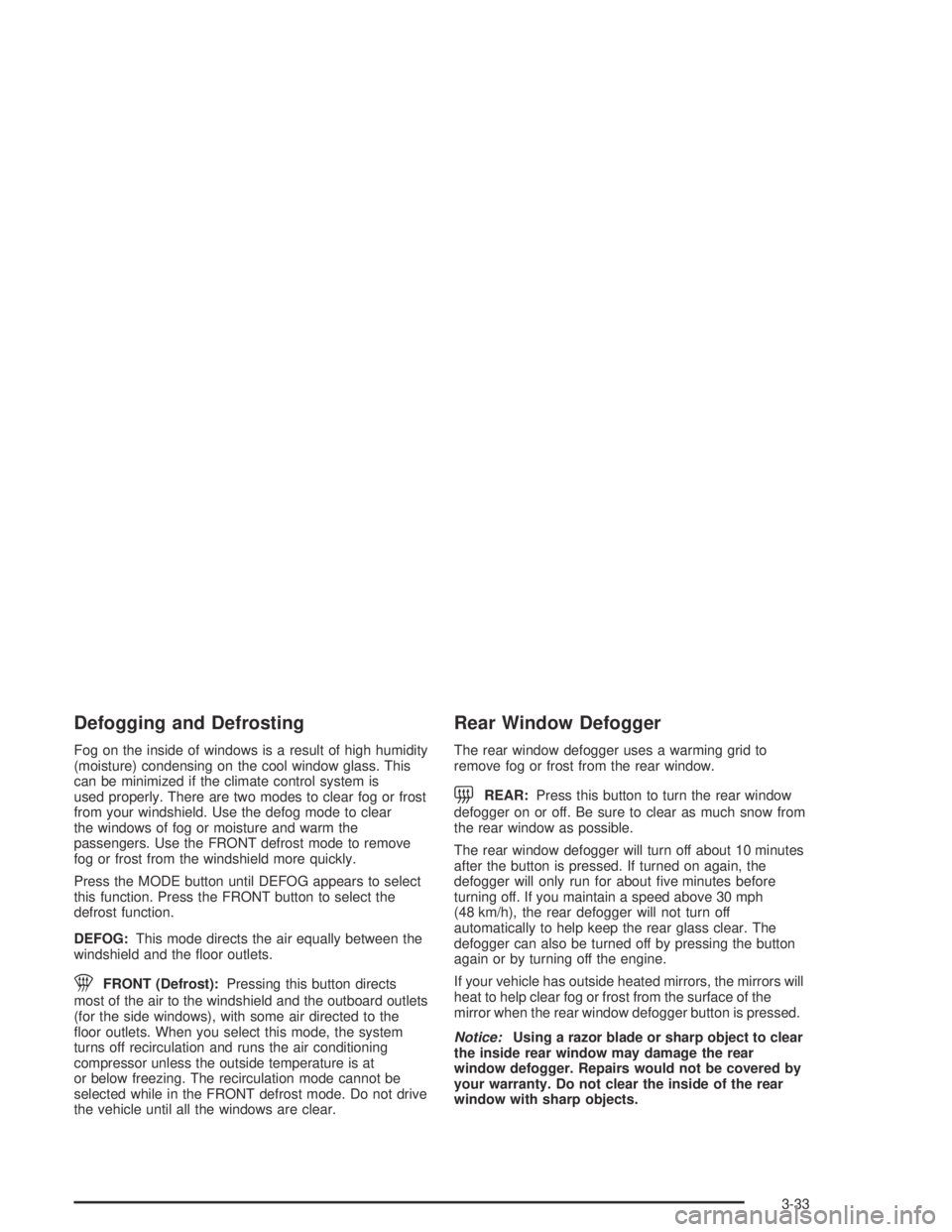
Defogging and Defrosting
Fog on the inside of windows is a result of high humidity
(moisture) condensing on the cool window glass. This
can be minimized if the climate control system is
used properly. There are two modes to clear fog or frost
from your windshield. Use the defog mode to clear
the windows of fog or moisture and warm the
passengers. Use the FRONT defrost mode to remove
fog or frost from the windshield more quickly.
Press the MODE button until DEFOG appears to select
this function. Press the FRONT button to select the
defrost function.
DEFOG:This mode directs the air equally between the
windshield and the �oor outlets.
1FRONT (Defrost):Pressing this button directs
most of the air to the windshield and the outboard outlets
(for the side windows), with some air directed to the
�oor outlets. When you select this mode, the system
turns off recirculation and runs the air conditioning
compressor unless the outside temperature is at
or below freezing. The recirculation mode cannot be
selected while in the FRONT defrost mode. Do not drive
the vehicle until all the windows are clear.
Rear Window Defogger
The rear window defogger uses a warming grid to
remove fog or frost from the rear window.
=REAR:Press this button to turn the rear window
defogger on or off. Be sure to clear as much snow from
the rear window as possible.
The rear window defogger will turn off about 10 minutes
after the button is pressed. If turned on again, the
defogger will only run for about �ve minutes before
turning off. If you maintain a speed above 30 mph
(48 km/h), the rear defogger will not turn off
automatically to help keep the rear glass clear. The
defogger can also be turned off by pressing the button
again or by turning off the engine.
If your vehicle has outside heated mirrors, the mirrors will
heat to help clear fog or frost from the surface of the
mirror when the rear window defogger button is pressed.
Notice:Using a razor blade or sharp object to clear
the inside rear window may damage the rear
window defogger. Repairs would not be covered by
your warranty. Do not clear the inside of the rear
window with sharp objects.
3-33
Page 167 of 446
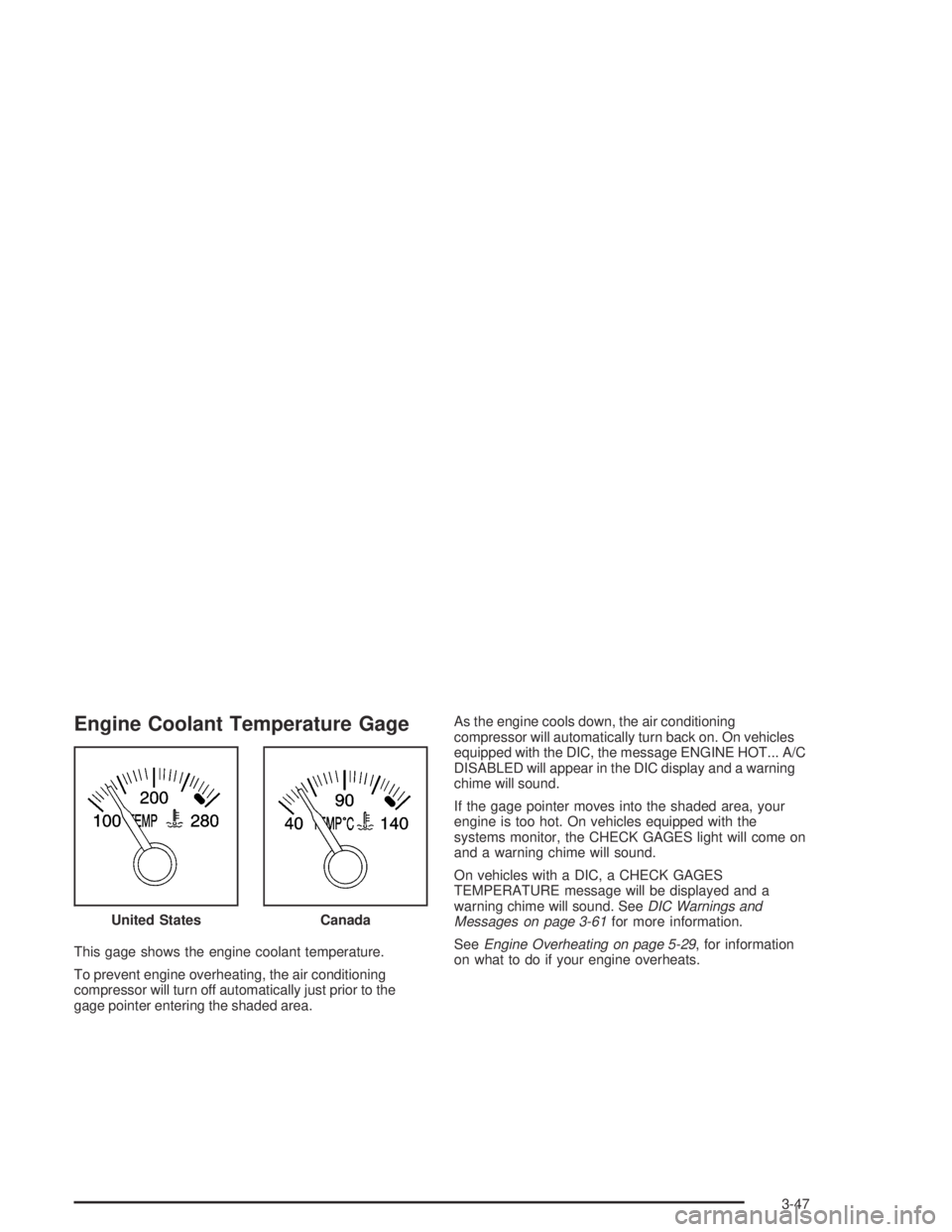
Engine Coolant Temperature Gage
This gage shows the engine coolant temperature.
To prevent engine overheating, the air conditioning
compressor will turn off automatically just prior to the
gage pointer entering the shaded area.As the engine cools down, the air conditioning
compressor will automatically turn back on. On vehicles
equipped with the DIC, the message ENGINE HOT... A/C
DISABLED will appear in the DIC display and a warning
chime will sound.
If the gage pointer moves into the shaded area, your
engine is too hot. On vehicles equipped with the
systems monitor, the CHECK GAGES light will come on
and a warning chime will sound.
On vehicles with a DIC, a CHECK GAGES
TEMPERATURE message will be displayed and a
warning chime will sound. SeeDIC Warnings and
Messages on page 3-61for more information.
SeeEngine Overheating on page 5-29, for information
on what to do if your engine overheats. United States
Canada
3-47
Page 169 of 446
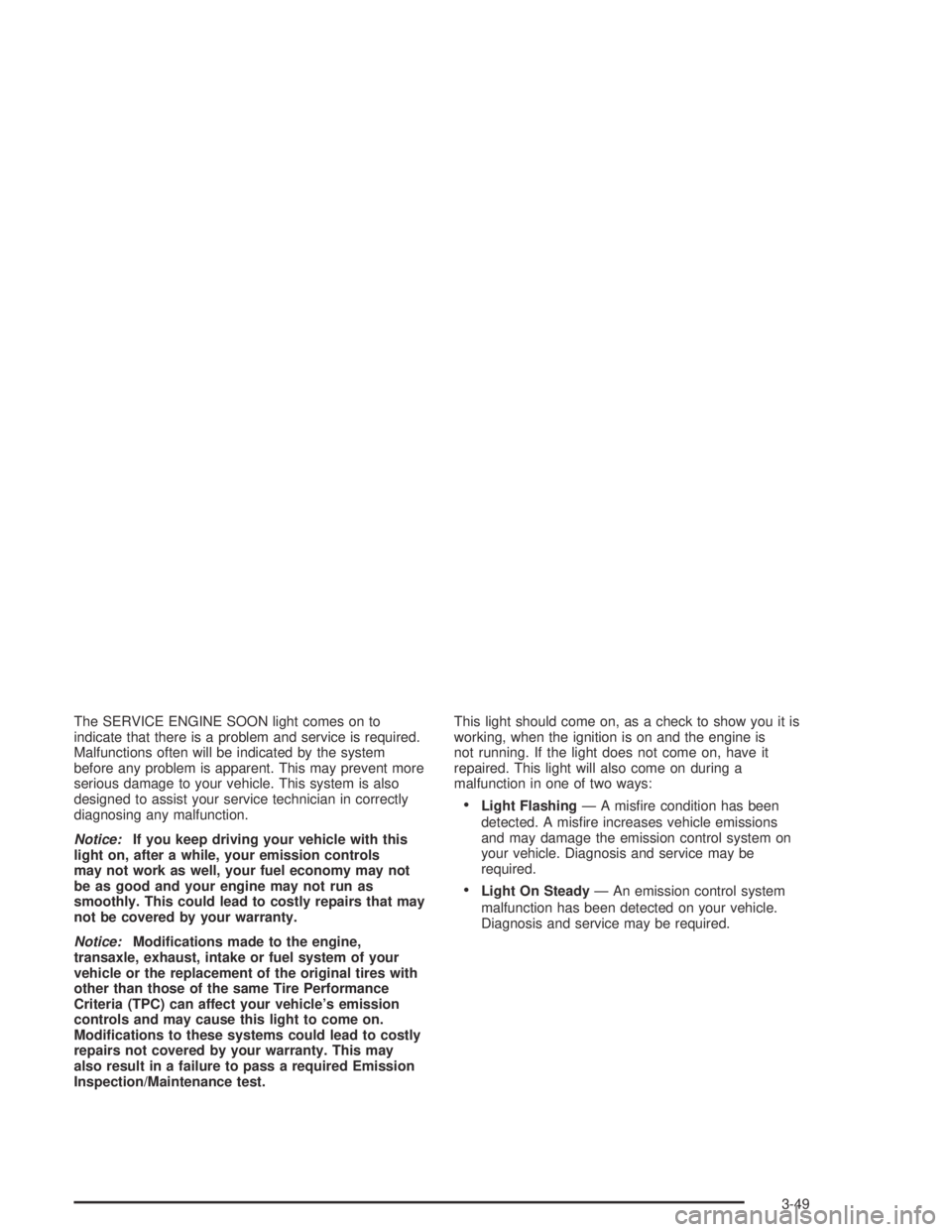
The SERVICE ENGINE SOON light comes on to
indicate that there is a problem and service is required.
Malfunctions often will be indicated by the system
before any problem is apparent. This may prevent more
serious damage to your vehicle. This system is also
designed to assist your service technician in correctly
diagnosing any malfunction.
Notice:If you keep driving your vehicle with this
light on, after a while, your emission controls
may not work as well, your fuel economy may not
be as good and your engine may not run as
smoothly. This could lead to costly repairs that may
not be covered by your warranty.
Notice:Modi�cations made to the engine,
transaxle, exhaust, intake or fuel system of your
vehicle or the replacement of the original tires with
other than those of the same Tire Performance
Criteria (TPC) can affect your vehicle’s emission
controls and may cause this light to come on.
Modi�cations to these systems could lead to costly
repairs not covered by your warranty. This may
also result in a failure to pass a required Emission
Inspection/Maintenance test.This light should come on, as a check to show you it is
working, when the ignition is on and the engine is
not running. If the light does not come on, have it
repaired. This light will also come on during a
malfunction in one of two ways:
Light Flashing— A mis�re condition has been
detected. A mis�re increases vehicle emissions
and may damage the emission control system on
your vehicle. Diagnosis and service may be
required.
Light On Steady— An emission control system
malfunction has been detected on your vehicle.
Diagnosis and service may be required.
3-49